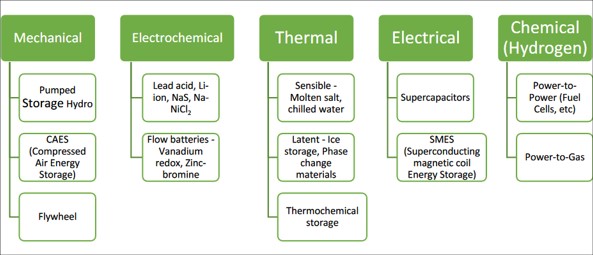India has set a target to achieve 50% cumulative installed capacity from non-fossil fuel-based energy resources by 2030 and has pledged to reduce the emission intensity of its GDP by 45% by 2030, based on 2005 levels. The incorporation of a significant amount of variable and intermittent Renewable Energy into the energy mix presents a challenge for maintaining grid stability and uninterrupted power supply. The challenge with Renewable Energy sources arises due to their varying nature with time, climate, season or geographic location. Energy Storage Systems (ESS) can be used for storing available energy from Renewable Energy and further can be used during peak hours of the day. The various benefits of Energy Storage are help in bringing down the variability of generation in RE sources, improving grid stability, enabling energy/ peak shifting, providing ancillary support services, enabling larger renewable energy integration, brings down peak deficit and peak tariffs, reduction of carbon emissions, deferral of transmission and distribution capex, energy arbitrage etc.
As per National Electricity Plan (NEP) 2023 of Central Electricity Authority (CEA), the energy storage capacity requirement is projected to be 82.37 GWh (47.65 GWh from PSP and 34.72 GWh from BESS) in year 2026-27. This requirement is further expected to increase to 411.4 GWh (175.18 GWh from PSP and 236.22 GWh from BESS) in year 2031-32. Further, CEA has also projected that by the year 2047, the requirement of energy storage is expected to increase to 2380 GWh (540 GWh from PSP and 1840 GWh from BESS), due to the addition of a larger amount of renewable energy in light of the net zero emissions targets set for 2070. A long-term trajectory for Energy Storage Obligations (ESO) has also been notified by the Ministry of Power to ensure that sufficient storage capacity is available with obligated entities. As per the trajectory, the ESO shall gradually increase from 1% in FY 2023-24 to 4% by FY 2029-30, with an annual increase of 0.5%. This obligation shall be treated as fulfilled only when at least 85% of the total energy stored is procured from Renewable Energy sources on an annual basis.
There are several energy storage technologies available, broadly – mechanical, thermal, electrochemical, electrical and chemical storage systems, as shown below:




